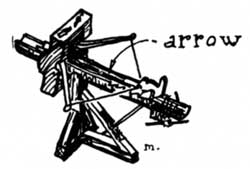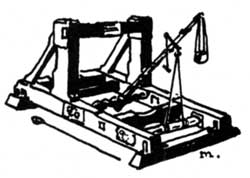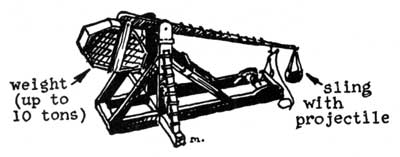|
|
|
 |
Artillery Throughout the Ages
Looking at an
old-time cannon, most people are sure of
just one thing: the shot came out of the
front end. For that reason these pages
are written; people are curious about
the fascinating weapon that so
prodigiously and powerfully lengthened
the warrior's arm. And theirs is a
justifiable curiosity, because the
gunner and his "art" played a
significant role in our history.
THE ANCIENT ENGINES
OF WAR
To compare a Roman
catapult with a modern trench mortar
seems absurd. Yet the only basic
difference is the kind of energy that
Sends the projectile on its way.
In the dawn of
history, war engines were performing the
function of artillery (which may be
loosely defined as a means of hurling
missiles too heavy to be thrown by
hand), and with these crude weapons the
basic principles of artillery were laid
down. The Scriptures record the use of
ingenious machines on the walls of
Jerusalem eight centuries B. C.—machines
that were probably predecessors of the
catapult and ballista, getting power
from twisted ropes made of hair, hide or
sinew. The ballista had horizontal arms
like a bow. The arms were set in rope; a
cord, fastened to the arms like a
bowstring, fired arrows, darts, and
stones. Like a modern field gun, the
ballista shot low and directly toward
the enemy.

FIGURE 1—BALLISTA. Caesar covered his
landing in Britain with fire from
catapults and ballistas.
The catapult was the
howitzer, or mortar, of its day and
could throw a hundred-pound stone 600
yards in a high arc to strike the enemy
behind his wall or batter down his
defenses. "In the middle of the ropes a
wooden arm rises like a chariot pole,"
wrote the historian Marcellinus. "At the
top of the arm hangs a sling. When
battle is commenced, a round stone is
set in the sling. Four soldiers on each
side of the engine wind the arm down
until it is almost level with the
ground. When the arm is set free, it
springs up and hurls the stone forth
from its sling." In early times the
weapon was called a "scorpion," for like
this dreaded insect it bore its "sting"
erect.

FIGURE 2—CATAPULT.
The trebuchet was
another war machine used extensively
during the Middle Ages. Essentially, it
was a seesaw. Weights on the short arm
swung the long throwing arm.

FIGURE 3—TREBUCHET. A heavy trebuchet
could throw a 300-pound stone 300 yards.
These weapons could
be used with telling effect, as the
Romans learned from Archimedes in the
siege of Syracuse (214-212 B.C.). As
Plutarch relates, "Archimedes soon began
to play his engines upon the Romans and
their ships, and shot stones of such an
enormous size and with so incredible a
noise and velocity that nothing could
stand before them. At length the Romans
were so terrified that, if they saw but
a rope or a beam projecting over the
walls of Syracuse, they cried out that
Archimedes was leveling some machine at
them, and turned their backs and fled."
Long after the
introduction of gunpowder, the old
engines of war continued in use. Often
they were side by side with cannon. |
Click on the Piece of Eight to return to the Main Page
 |
|
 |
|
|
|

